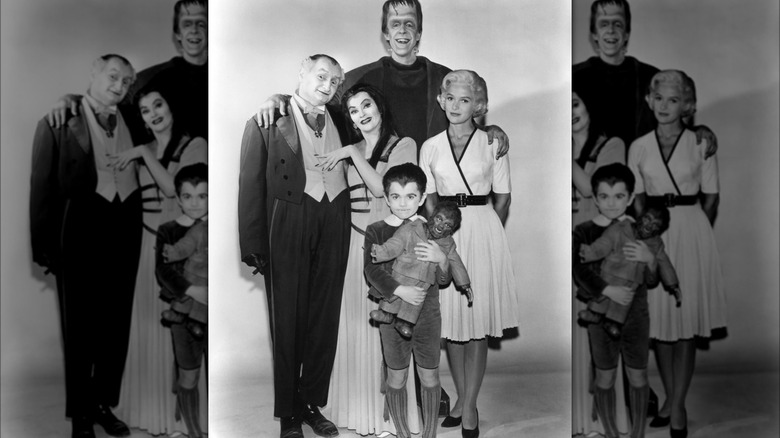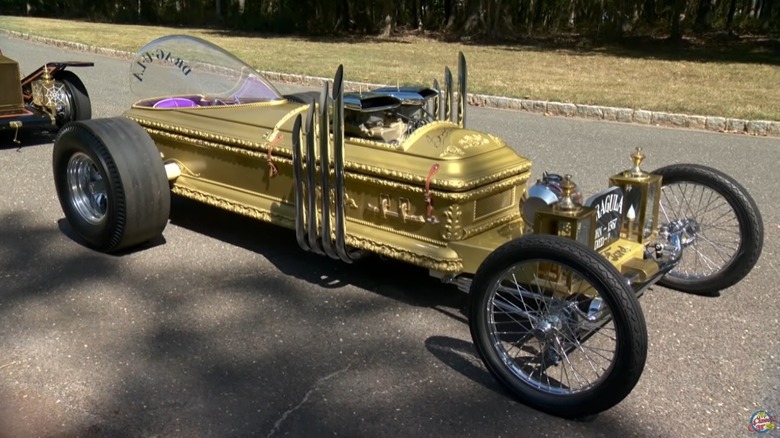One Fast Coffin: What Ever Happened To The Drag-U-La?
Back in the 1960s, American television was littered with shows that eventually became indelibly etched into pop culture. "The Addams Family," "Gilligan's Island," "I Dream of Jeanie," "Batman," and dozens of others (the list goes on forever) are looked back on fondly, and perhaps not without a lot of smirks.
One of those shows was a silly short-lived sitcom about a family of monsters called "The Munsters," which included husband Herman (a Frankenstein-like monster), his wife Lily (a vampire), Grandpa (also a vampire), and children Marilyn (who oddly was a monster) and Eddie (a kid werewolf). Don't ask, just watch.
The show only aired for two years (between 1964 and 1966) with just 70 episodes, but you'd be hard-pressed to find someone of even a younger generation who hasn't at least heard of the hilariously macabre household thanks to never-ending reruns in syndication. And if not that, then via Rob Zombie's 2022 Munster movie remake.
During the first season (episode 36, entitled "Hot Rod Herman," airdate May 27, 1965), son Eddie brags to a female friend that his dad (Herman) can beat her dad in a race down at the Mockingbird Heights drag strip. Herman, of course, doesn't win and loses the family car known as the Munster Koach (also seen in the same episode) in the process. This angers Lily, but Grandpa has a "brilliant" plan to get it back — they'll build a dragster (in the garage) that can't be beaten. Enter the Drag-u-la.
One sick dragster for Dracula
This dragster for Dracula (Drag-u-la, get it?) was purpose-built for this one episode by Dick Dean while working for the world-famous Barris Kustoms car shop (the "original" King of Kustomizers) in Hollywood, California. Designed by Tom Daniel, who created both the Drag-u-la and Munster Koach, it was likely meant to tap into the ever-growing fascination the American public had with drag racing at the time.
Daniel would design some 80 cars during his career, and if these two ring a nostalgic childhood bell, it could be because they were some of the many model car kits Monogram made back in the day.
They wanted a coffin to be the dragster's centerpiece to keep with a vampire theme. But back in the '60s, it was illegal to sell one without a legal death certificate. Unfazed, Barris' project engineer (Richard "Korky" Korkes) worked an off-the-books deal wherein a local funeral home director left one outside one night, and it mysteriously ended up in an episode of "The Munsters." Go figure.
The fiberglass coffin was bolted to a tubular steel dragster chassis (reportedly a Ford T-bucket frame) and decked out with an assortment of horror movie props — the "grill" was Grandpa's tombstone (complete with a born-on-date) framed by large, custom lanterns as headlights. Smaller lanterns sat in the back as rear tail lights. Purple satin interior with gold lamé lined the interior, while pipes ostensibly ripped from Grandpa's organ acted as long upswept Zoomie-style exhaust pipes. A transparent bubble that looked like a plane's cockpit canopy covered the driver.
Coffin confusion
Sitting at its heart was a Ford Mustang 289-cubic-inch V8 engine, topped by two four-barrel carburetors mounted on top of a Mickey Thompson Ram-Thrust intake manifold, all of which produced 350 horsepower to the rear wheels via a C-4 automatic transmission. This thing didn't just look sick but was, by all accounts, functionally fast as well.
In the end, Grandpa wins the race in the Drag-u-la and wins back the Munster Koach. Ironically, fans loved it so much that producers included it in the show's end credits the next year. While it was never in another episode, a modified version appeared in the 1966 movie "Munsters, Go Home!" They had to replace the plexiglass bubble with a tubular roll bar so actor Fred Gwynne (who played Herman) could fit inside the car.
A total of five Drag-u-la's were reportedly built for the show. Some sat in museums or private collections, while one even hung from the ceiling at the long-defunct Planet Hollywood in Atlantic City. Since several replicas have also been built, many of the "originals" have become obfuscated over time, so there is now some confusion as to what is and isn't "original."
In October 2021, both Jalopnik and autoevolution reported that one of the five "original" cars was headed to Mecum's Kissimmee January 2022 auction. However, links in those articles to that specific lot listing no longer work, and a detailed search of that year's Kissimmee auction failed to turn up any record that the Drag-u-la was ever even included.
Real or replica, that is the question
Keith Dean — son of Dick Dean, who made the first one — and Jim Johnson of Barris Kustom built an official replica using photographs of that original. George Barris himself consulted on the project. It was sold at a Bonhams auction for $51,750 in May 2005.
Dean built another Drag-u-la, known as the number three car, as a giveaway for a casino in Florida, which raffled it off on Halloween. An elderly woman won and promptly put it in storage for years before it finally ended up with (as of 2020) a member of the Dead Man's Curve car club in New Jersey.
Butch Patrick (who played Eddie Munster) had a replica made by Kustomizer Rucker Posey to take with him on promotional tours. It is strapped with a 400-horsepower Chevrolet engine and a functional dual quad intake mated to a TH350 transmission. It is currently for sale at Volo Auto Sales for $59,998 (with an appraised value of $75,000).
In September 2019, Heritage Auctions sold what it listed as a heavily modified — but still the "original" — Drag-u-la that appeared in both the TV show and the movie. Not only was the Ford V8 engine removed (for display purposes), but the intake scoops, seat, and rear wheels were all replaced. It sold for $112,500, substantially more than the replicas, so it's likely the real deal.
Both the Drag-u-la and Munster Koach (although it's unclear if these were originals or replicas) appeared at the AutoFair at Charlotte Motor Speedway in April 2023. While neither is considered one of the most iconic TV cars of all time, they're still memorable in their own right.

